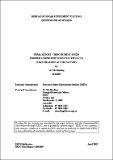| Abstract | Declining ccs in the Mossman-Tully region has been linked to increasing extraneous matter in mill-supply cane. This was quantified by measuring the proportion and quality of crop fractions in pre-and post-harvest subsamples. These were taken from 54 sites in 1999 and 2000, dissected into basic crop components, quantified, and analysed for five quality components. In March-July 2000, 14 sites with crops showing pre-harvest-season stalk-habit variation - erect versus lodged - were sampled three times. Pre-harvest habit had a marked effect on crop ccs. Lodged, unsound cane had a mean ccs 25% less than erect, sound cane. Relatively, average mill ccs compared poorly with pre-harvest potential ccs (75.9 and 85.1% for 1999 and 2000, respectively) and post-harvest potential ccs (83 and 87%). Mill-realised ccs was marginally above the average, weighted, whole-crop, in-field ccs, in both years, almost equalled the post-harvest ccs in 1999, and was just below in 2000. In 1999, harvesting did not reduce the in-field extraneous matter content (18.9%). In 2000, the proportion changed from 18.9 to 13.1%. An erect crop maximises quality and must be addressed by crop improvement and agronomy activities. The results severely question the efficacy of current harvesting technology, or how this is being used. |
| Keywords | Extraneous matter, efficacy, harvest technology, rat damage, rats, harvest season sampling, Leslie and Wilson report SRDC, Mulgrave Mill |

